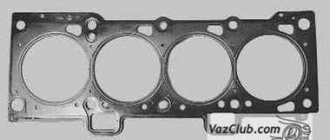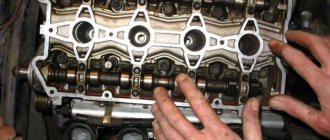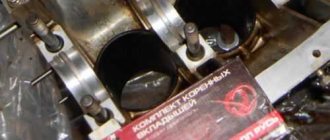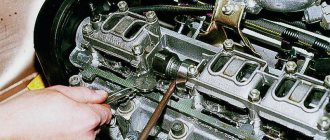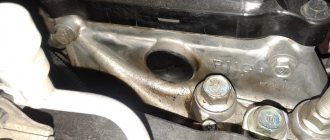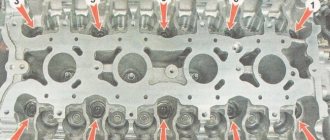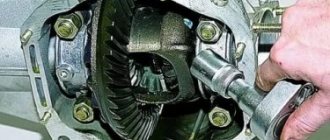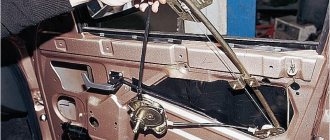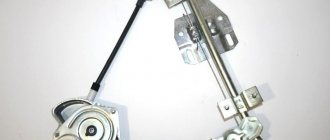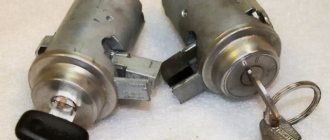Share:
Tightening torques for the VAZ cylinder head are the topic of this article. It shows the tightening torques for the cylinder head of various VAZ vehicles. Tightening diagrams for VAZ cylinder head bolts of different models are posted. The sequence of tightening the cylinder head bolts for each VAZ engine is described. Marks of bolts connecting the cylinder head to the engine block are laid out.
The tightening torque of the VAZ cylinder head is the size of the tightening force of the fasteners of the cylinder head of a VAZ car engine, at which the threads of the hardware do not break and the body of the cylinder head does not deteriorate.
Tightening torques for the cylinder head of the VAZ 2101 engine
Tightening the cylinder head bolts 2101-1003271 and 1/60441/30 must be done 2 times, in the order shown in the image.
The tool used is a 19mm head, a 13mm head, a collar and a rod or ratchet
Tightening torques for cylinder head bolts 1 to 10:
- 1 time - 34 ÷ 42 N/m;
- 2 times - 100 ÷ 120 N/m.
Torque of head bolts No. 11:
- Primary moment - 14 ÷ 16 N/m;
- The final force is 32 ÷ 40 N/m.
How to tighten the engine head of a VAZ 2110
- To the beginning of the forum
- Forum Rules
- Old design
- FAQ
- Search
- Users
The cylinder head gasket needs to be replaced.
According to the manual everything is correct. The main thing is not the force on the key, but the same 0.6575 mm by which the gasket should compress. one turn of the bolt by 1.25 mm recesses it. but all this works when the planes are ideal.
The cylinder block is cast from cast iron and has the index “21083” - like the engines 2110 and 2111, however they are not interchangeable: the holes for the cylinder head screws have a thread M10x1.25 (as opposed to M12x1.25 for engine blocks 2110 and 2111) and smaller depth. Another difference is related to the more intense thermal regime of the 2112 engine compared to the 2110 and 2111 engines.
Do you notice the difference in the M10 and M12 bolts?
The cylinder block is cast from cast iron and has the index “21083” - like the engines 2110 and 2111, however they are not interchangeable: the holes for the cylinder head screws have a thread M10x1.25 (as opposed to M12x1.25 for engine blocks 2110 and 2111) and smaller depth. Another difference is related to the more intense thermal regime of the 2112 engine compared to the 2110 and 2111 engines.
Do you notice the difference in the M10 and M12 bolts?
I pulled it in by eye, I don’t know what will happen next.
When you need an exact tightening torque, I always use a universal torque wrench, which consists of three parts: 1) A piece of suitable pipe 0.3. 1.0 m (for me it’s a leg from a stool) 2) Kitchen steelyard for 10 kg (you can get it from your wife in the kitchen) 3) Calculator for recalculating the steelyard readings (you can use it from your mobile phone). If the pipe is 1 m long, then it is not needed, because it can be divided into “one” in your mind.
By the way, I tightened my cylinder head with this key in the Murzilka. Everything went perfect.
When you need an exact tightening torque, I always use a universal torque wrench, which consists of three parts: 1) A piece of suitable pipe 0.3. 1.0 m (for me it’s a leg from a stool) 2) Kitchen steelyard for 10 kg (you can get it from your wife in the kitchen) 3) Calculator for recalculating the steelyard readings (you can use it from your mobile phone). If the pipe is 1 m long, then it is not needed, because it can be divided into “one” in your mind.
By the way, I tightened my cylinder head with this key in the Murzilka. Everything went perfect.
you must do as it is written in the Murzilka. I mixed it up myself and tightened it according to the principle of the VAZ 2110, and I have a 2112. Now a little oil is siphoning from under the gasket. although the cylinder head was new, it was tightened so that the bolts were stuck and the two of us could no longer tighten it with a torque wrench, it took a lot of force
Is it leaking or just sweating?
So, the VAZ 2112 lacks the second step (69.4-85.7 Nm), which is a very significant point.
Source
Tightening torques for the cylinder head of the VAZ 2102 engine
Tightening the cylinder head fasteners must be done in 2 steps, according to the sequence indicated in the drawing below.
To tighten it, we use a 19 and 13 socket head, as well as a torque wrench.
Screwing force for cylinder head mounting from 1 to 10:
- Initial - 3.4 ÷ 4.2 kgf/m;
- Final - 10 ÷ 12 kgf/m.
Screwing force of the bolts of the head of block No. 11:
- First time - 1.4 ÷ 1.6 kgf/m;
- The second is 3.2 ÷ 4.0 kgf/m.
Is it possible to increase the power of a VAZ 2107 engine by installing a different camshaft?
Probably, every owner of the “Seven” wants the engine of his car to work not only without interruptions, but also with maximum efficiency. Therefore, some craftsmen are trying to tune power units using various methods. One of these methods is to install a different, more “advanced” camshaft.
The essence of tuning
Theoretically, it is possible to increase the power performance of a power unit by increasing the phase width and lift height of the intake valve. The first indicator determines the period of time during which the intake valve will be open, and is expressed in the angle of rotation of the timing shaft. For the “seven” it is 232o. The lift height of the intake valve determines the area of the hole through which the fuel-air mixture will be supplied to the combustion chamber. For VAZ 2107 it is 9.5 mm. Thus, again, in theory, as these indicators increase, we get a larger volume of combustible mixture in the cylinders, which can really have a positive effect on the power of the power unit.
The phase width and lift height of the intake valve can be increased by changing the configuration of the corresponding cams of the gas distribution shaft. Since such work cannot be done in a garage, for such tuning it is better to use a finished part from another car.
Camshaft from Niva
There is only one car whose camshaft is suitable for the “seven”. This is a VAZ 21213 Niva. Its timing shaft has a phase width of 283°, and the intake valve lift is 10.7 mm. Will installing such a part on a VAZ 2107 engine give anything in reality? Practice shows that yes, there is a slight improvement in the operation of the power unit. The power increase is approximately 2 liters. s., but only at low revs. Yes, the “seven” responds a little sharper to pressing the accelerator pedal at the start, but once it gains speed, its power becomes the same.
Sports camshafts
In addition to the timing shaft from Niva, the VAZ 2107 can also be equipped with one of the shafts made specifically for “sports” tuning of power units. Such parts are produced by a number of domestic enterprises. Their cost ranges from 4,000–10,000 rubles. Let's look at the characteristics of such camshafts.
Table: main characteristics of “sports” timing shafts for VAZ 2101–2107
| Name | Phase width, 0 | Valve lift height, mm |
| "Estonian" | 256 | 10,5 |
| "Estonian +" | 289 | 11,2 |
| "Estonian-M" | 256 | 11,33 |
| Shrik-1 | 296 | 11,8 |
| "Shrik-3" | 304 | 12,1 |
Tightening torques for cylinder head of VAZ 2106 and VAZ 2121
The block head bolts are tightened in 2 approaches, according to the diagram shown below.
To do this, we use a head for 19 and 13, as well as a torque wrench
| Engine model | Cylinder head bolt number | Tightening torques for VAZ cylinder head bolts, N/m | |
| Elementary | Final | ||
| VAZ 2106 | from 1 to 10 | 34 ÷ 4,2 | 10 ÷ 12 |
| 11 | 14 ÷ 16 | 32 ÷ 40 | |
| VAZ 2121 | from 1 to 10 | 34 ÷ 4,2 | 10 ÷ 12 |
| 11 | 14 ÷ 16 | 32 ÷ 40 | |
Lada 2107 7up › Logbook › Two methods of tightening the cylinder head. Which one is correct? Let's figure it out.
I once had to climb into the engine and remove the head due to a burnt-out valve. Then the question arose: how to actually tighten the cylinder head according to science? In different manuals, this operation is described by two methods. 1. Tighten in several passes to a torque of 10.5-12 kg/m 2. Pull in several passes to 8 kg and then turn 90 degrees 2 times. Which method should you choose? The second method supposedly puts the bolts into elastic deformation mode, stretching them like a spring, while the moment goes beyond 13 kg/m. Being in a stretched state, the bolts compensate for the subsequent shrinkage of the gasket and tightening the bolts is no longer required. It goes without saying that re-tightening old bolts is fraught with entering the zone of plastic deformation and subsequent breakage. The fact that the bolts should be tensioned is in principle correct, but how can this be checked? Right! Moment! Having come to this conclusion, I decided to stall purely for the moment, and at the same time see how effective the second method would be. I took a click wrench marked up to 32 kg. I started with a smooth tightening from 2 kg in several passes and reached 11 kg and then the fun began. Each bolt began to live its own life. 70% of the bolts clicked when turned at the same angle, while the rest required turning more than 90 degrees to click. The cylinder head was previously milled and the plane of the block was carefully cleaned with a scraper. It turned out that the real compression of the gasket began only after 11 kg and took place in different areas with different intensities. If I had used the angle method, I would have gotten a scatter of moment across the entire plane and a bend in the cylinder head, which would have inevitably led to gasket burnout. Why is the gasket crimped at different speeds over its entire area? This may be due to the design features of the gasket itself; perhaps there is a curvature of the plane of the cylinder block. In any case, it is necessary to tighten solely using the torque on the torque wrench; this is the only way to guarantee tight and, most importantly, uniform pressing of the cylinder head plane to the block. At what torque should you turn? I settled on 13.5 kg, perhaps a bit too much, but good compression is guaranteed.
Mileage: 89100 km
Like 17 Subscribe
Tightening torques for the cylinder head of VAZ 21073, 21213, 21214, 21214-10
Tightening bolts 1 ÷ 10, models 21213-1003271 and 1/60441/30 is performed in 4 approaches in the order shown in the picture.
The tool used is a 12mm head, a 13mm head, a curved drap and an extension or ratchet.
| Engine model | Cylinder head bolt number | Tightening torque of VAZ cylinder head bolts, N/m | |||
| Elementary | Second time | Third time | Final | ||
| VAZ 21073 | from 1 to 10 | 12 ÷ 20 | 50 ÷ 70 | rotates 90o ÷ 110o | rotates 90o ÷ 110o |
| 11 | 14 ÷ 16 | 32 ÷ 40 | — | — | |
| VAZ 21213 | from 1 to 10 | 12 ÷ 20 | 50 ÷ 70 | rotates 90o ÷ 110o | rotates 90o ÷ 110o |
| 11 | 14 ÷ 16 | 32 ÷ 40 | — | — | |
| VAZ 21214 | from 1 to 10 | 12 ÷ 20 | 50 ÷ 70 | rotates 90o ÷ 110o | rotates 90o ÷ 110o |
| 11 | 14 ÷ 16 | 32 ÷ 40 | — | — | |
| VAZ 21214-10 | from 1 to 10 | 12 ÷ 20 | 50 ÷ 70 | rotates 90o ÷ 110o | rotates 90o ÷ 110o |
| 11 | 14 ÷ 16 | 32 ÷ 40 | — | — | |
The nuances of replacing the gasket
Some resources advise studying the gasket to find out what kind of damage has occurred on it. This, in fact, is just a waste of time, because the specified element cannot be repaired. Just throw away the old one and install a new one.
It is necessary to stop at the last point. After removing the old sealing element, thoroughly clean the surface underneath it. If necessary, treat with fine sandpaper - only on an ideal, even base does it make sense to install the purchased gasket. The slightest bulge, even with proper tightening, will cause a leak.
Tightening torques for VAZ 2109 cylinder head
The cylinder head bolts must be tightened in four steps, in the sequence shown in the diagram below
Mount the cylinder head on the block. Before doing this, check that the crankshaft and camshaft are located at TDC (all valves of the 1st pot must be closed). Tighten the head bolts in the following order, in 4 steps:
| 1 | moment 2 kgf-m; |
| 2 | moment 7.1 - 8.7 kgf-m; |
| 3 | turn 90o; |
| 4 | tighten 90o. |
Removing the cylinder head - important points
Before working on the head, you need to remove the timing chain. To do this, carefully loosen its tensioner, and then completely dismantle it. Then comes the turn of the camshaft gear. It is held in place by a bolt - unscrew it. It is important that the chain does not fly off the sprocket - fixing it with a piece of thick copper wire will save you from this trouble.
Now proceed to disconnect the camshaft - it is screwed to the cylinder head in 9 places. Their tightening is not too strong, and therefore there will be no difficulties at this stage. Otherwise, use WD-40 again.
With the shaft removed, disconnect the fuel inlet pipe and exhaust manifold. From this point on, nothing prevents you from working on the head itself - screw in 11 bolts, and the job is done.
Tightening torques for the head of the block VAZ 2108 - 21083, 2110, 2111
Screw in the bolts 4 times in the order shown in the image
For screwing, the following tool is used: adapter 67.7812-9543 for bolts of brand 2108-1003271, wrench TL-98-110 with parameters E14 for bolts of brand 2108-1003271-01, bend and extension or power tool of brand IP - 3111.
| Engine model | Cylinder head bolt number | Tightening torque of VAZ cylinder head bolts, N/m | |||
| Elementary | Second time | Third time | Final | ||
| VAZ 2108 - 21083 | from 1 to 10 | 18 ÷ 22 | 70 ÷ 85 | turn it 90o | turn 90o |
| VAZ 2110 | from 1 to 10 | 18 ÷ 22 | 70 ÷ 85 | turn it 90o | turn 90o |
| VAZ 2111 | from 1 to 10 | 18 ÷ 22 | 70 ÷ 85 | turn it 90o | turn 90o |
Bolts in VAZ family cars
Fasteners are presented in a wide range, they have different sizes and purposes. For example, the rear door shock absorber mounting bolt 2108-09 or the roof support mounting bolt. If you are repairing a generator, you will also need the appropriate fastener. Even to fix a ball license plate, certain hardware is needed.
The photo shows the cylinder head bolts of a VAZ 2108.
Bolts for alloy wheels
VAZ wheel bolts are designed for fixing alloy wheels, the total length is 51 mm. Approximate cost of elements:
Wheel bolts on VAZ for alloy wheels have a thread length of 28, 30 and 33 millimeters. Standard factory fasteners come with dimensions of 12×1.25 with a total length of 44 mm and a thread length of 24 mm.
Transmission mounting bolt
M12×45 brand fasteners are suitable as standard parts for transmissions and gearboxes on VAZ 2101, 2102, 2103, 2104, 2105, 2106, 2107 models. For VAZ gearboxes, M 12×1.24 Belebey fasteners are used.
Arm bolts
A broken beam bolt (rear suspension arm) is usually discovered when trying to perform wheel alignment. The result is a discovered lever that is not properly secured. On VAZ cars, there are no problems replacing the upper arm, since the fasteners are clearly visible and easy to reach. Bend the pressing petal and knock out the 14x243 element. You will have to work longer with the rear fasteners, since you have to remove the hardware through the lower hole in the beam. It is recommended to use a screwdriver or tweezers as tools.
Using available tools, install new bolts. When replacing, do not dismantle the lower arm. When one hardware is unscrewed and removed, the second one must be fully tightened. This will allow fastening without distortion of the lower axis. It is recommended to have a jack on hand, which should be placed under the lower arm mount and at the same time adjust its position. This technique will lighten the load on the bolt and simplify installation.
Tightening torques for the head of the block VAZ 2113, 2114, 2115
Tighten the bolts in four steps, in the order shown in the image
To tighten the bolts, you must use a Torx E14 socket wrench.
Warnings! Reuse of cylinder head bolts is only permitted if their length does not exceed 135.5 mm
Using a caliper or a mechanic's ruler, measure the length of the bolts.
Important ! Bolts longer than 135.5 mm are replaced.
Tighten the M12XI.25 cylinder head mounting bolts 4 times:
- Initial force - 2 kgf/m;
- Second time - 7 ÷ 8.6 kgf/m;
- Third time - turn it 90°;
- The fourth time - tighten the bolts 90°.
The remaining tightening torques for bolts and nuts of all threaded connections of VAZ 2113, 2114, 2115 vehicles can be found here
Reasons for proper tightening
As noted above, tightening is carried out after disassembling the cylinder head, and it, in turn, is most often performed when it becomes necessary to replace the gasket in model 2107. In most cases, a malfunction of the element in question is grounds for prohibiting further operation of the vehicle.
A very common problem is wear of the gasket in the area between the lubrication channels and those responsible for the circulation of antifreeze. In this situation, mutual contamination of working fluids occurs. The characteristic symptoms are:
- oil dilution and a drop in its level;
- change in the shade of antifreeze (it begins to look like tea).
Such a breakdown requires urgent repair.
The second variant of the VAZ-2107 malfunction is loss of tightness in the area between the cylinders themselves and the coolant supply system. Typically the culprits here are:
- defective cylinder head gasket;
- insufficient tightening torque.
Regardless of this, the same thing happens - air enters the cooling system, and after that:
- coolant temperature rises;
- The distribution tank is literally boiling.
Much less often, the gasket is destroyed in the space between the cylinders. Signs of a malfunction include a drop in compression and unstable operation of the engine.
Many people look for the reasons for the failure in other places if they have recently replaced the cylinder head gasket, but this is just a waste of effort. The fact is that now such elements are often of low quality, and are sometimes produced in artisanal conditions. As a result, the seal fails in a matter of months. Take a close look to see if there are any leaks of antifreeze in the space between the cylinder block and the engine. If so, try tightening the bolts. When this measure does not help, then most likely the problem is an uneven gasket.
Tightening torques for VAZ 21114 cylinder head
Tighten the cylinder head bolts in four steps according to the diagram shown below in the figure:
To tighten the bolts, you must use an adapter type 02 15 12 10 f. "Stahlwille", 234 N 10L f. "USAG", IN 30L10 f. "GEDORE", S09H410 f. “JONNESWAY” for hardware 2108-1003271, replaceable head 14, wrench TL-98-110 size E14 for bolts 2108-1003271-01, wrench and extension or impact wrench type IP - 3111, torque wrench.
The tightening torque for the cylinder head bolts is:
- First reception - 18 ÷ 22 N.m (1.8 ÷ 2.2 kgf.m);
- Second reception - 70 ÷ 85 N.m (7.0 ÷ 8.5 kgf.m);
- The third step is to turn it 90°;
- The fourth technique is to twist it 90°.
Tightening torques for the cylinder head of the VAZ 11183 engine
Tighten the cylinder head hardware four times according to the drawing shown below:
To tighten the bolts you need to use an adapter type 02 15, 12 10 f. "Stahlwille", 234 N 10L f. "USAG", IN 30L10 f. "GEDORE", S09H410 f. “JONNESWAY” for dowels 2108-1003271, replaceable head 14, key TL-98-110 sizes E14. For bolts 2108-1003271-01 - gate and rod or wrench type IP - 3111, torque wrench.
The tightening torques for the block head bolts have the following parameters:
- 1 time - 18 ÷ 22 N.m (1.8 ÷ 2.2 kgf.m);
- 2 times - 70 ÷ 85 N.m (7.0 ÷ 8.5 kgf.m);
- 3 times - turn 90°;
- 4 times - turn it 90°.
Tightening torques for the cylinder head of the VAZ 21124 engine
Tighten the bolts in 4 stages in the order shown in the figure below:
To tighten the bolts, use the following tools: adapter type 02 15 12 10 lb. "Stahlwille", 234 N 10L ph. "USAG", IN 30L 10 lbs. “GEDORE”, S09H410 f. “JONNESWAY” for bolts 2112-1003271, replaceable head 14, wrench TL 98-110 size E14 for bolts 2112-1003271-01, wrench and extension or wrench type IP-3111, torque wrench ..
The tightening torque of the cylinder head bolts is:
- Stage 1 - 12 ÷ 20 N.m (1.2 ÷ 2.0 kgf.m);
- Stage 2 - 26 ÷ 34 N.m (2.6 ÷ 3.4 kgf.m);
- Stage 3 - turn by 90°;
- Stage 4 - turn by 90°.
Cylinder head cover and tightening order of its bolts
The metal cover installed on the cylinder head must not allow air to pass through. At points of contact with other parts, tightness must also be maintained. Therefore, sealant is applied to the edge of the lid. An example is shown in the photo.
Cylinder head cover before installation
Here you need to use materials: Loctite-574, ANACROL, etc. The screws on the cover are tightened with an “8” key.
You can unscrew the screws in any order. Their number is 15 or 14.
When installing, it is better to follow the sequence shown below.
The order of tightening the cap is marked with numbers and arrows
There is usually no need to replace the screws - the load is too small. We wish you success.
Tightening torques for the head of the VAZ 21126, 11194 engine block
Twist the hardware 4 times in the sequence shown below in the image:
For screwing, you must use the following tool: adapter 67.7812-9543 for bolts model 2108-1003271, wrench TL-98-110 with size E14 for bolts brand 2108-1003271-01, bend and rod or power tool model IP - 3111.
| Engine model | Cylinder head bolt number | Tightening torque of VAZ cylinder head, N/m | |||
| 1 time | 2 times | 3 times | 4 times | ||
| VAZ 21126 | from 1 to 10 | 12 ÷ 20 | 26 ÷ 34 | turn it 90o | turn 90o |
| VAZ 11194 | from 1 to 10 | 12 ÷ 20 | 26 ÷ 34 | turn it 90o | turn 90o |
